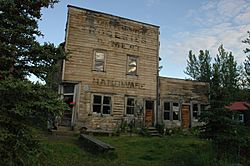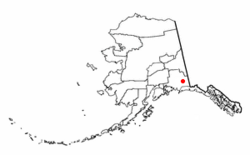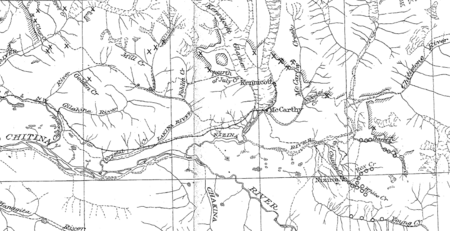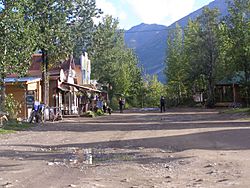McCarthy, Alaska facts for kids
Quick facts for kids
McCarthy, Alaska
|
|
|---|---|

The old McCarthy hardware store
|
|

Location of McCarthy, Alaska
|
|
| Country | United States |
| State | Alaska |
| Census Area | Copper River |
| Area | |
| • Total | 149.47 sq mi (387.14 km2) |
| • Land | 149.47 sq mi (387.14 km2) |
| • Water | 0.00 sq mi (0.00 km2) |
| Elevation | 1,401 ft (427 m) |
| Population
(2020)
|
|
| • Total | 107 |
| • Density | 0.72/sq mi (0.28/km2) |
| Time zone | UTC-9 (Alaska (AKST)) |
| • Summer (DST) | UTC-8 (AKDT) |
| Area code(s) | 907 |
| FIPS code | 02-45790 |
| GNIS feature ID | 1406098 |
McCarthy is a small community in Copper River Census Area, Alaska, United States. It's known as a census-designated place (CDP), which is a special area set up by the government for counting people. McCarthy is located inside the huge Wrangell-St. Elias National Park and Preserve. In 2020, only 107 people lived there, but that was a big jump from just 28 people in 2010!
Contents
Where is McCarthy Located?
McCarthy is about 193 kilometers (120 miles) northeast of a town called Cordova. It sits at the base of the mighty Wrangell Mountains. The area of McCarthy covers about 384 square kilometers (148 square miles) of land, with no water.
To get to McCarthy, you have to drive on the McCarthy Road. This road connects to the Edgerton Highway from Chitina. McCarthy is also the gateway to Kennecott, which is a popular spot for tourists visiting Wrangell–St. Elias National Park and Preserve.
Years ago, after the road ended, people had to cross the Kennecott River using special hand-pulled ropes. But now, there's a footbridge built in the 1990s, making it much easier to get across. Visitors can walk from the bridge to McCarthy in about 15 minutes. During the summer, shuttle vans and buses are also available to take tourists to both McCarthy and Kennecott.
McCarthy's Weather
McCarthy has a subarctic climate. This means it has very cold, long winters and short, cool summers. It's a place where you'll see a lot of snow in winter!
| Climate data for McCarthy | |||||||||||||
|---|---|---|---|---|---|---|---|---|---|---|---|---|---|
| Month | Jan | Feb | Mar | Apr | May | Jun | Jul | Aug | Sep | Oct | Nov | Dec | Year |
| Record high °F (°C) | 44 (7) |
48 (9) |
56 (13) |
71 (22) |
82 (28) |
89 (32) |
88 (31) |
85 (29) |
75 (24) |
72 (22) |
56 (13) |
44 (7) |
89 (32) |
| Mean daily maximum °F (°C) | 8.4 (−13.1) |
20.9 (−6.2) |
33.1 (0.6) |
47.4 (8.6) |
60.2 (15.7) |
69 (21) |
71.4 (21.9) |
66.4 (19.1) |
55.7 (13.2) |
38 (3) |
16.2 (−8.8) |
13 (−11) |
41.6 (5.3) |
| Mean daily minimum °F (°C) | −8.9 (−22.7) |
−2.2 (−19.0) |
2.6 (−16.3) |
20.5 (−6.4) |
29.9 (−1.2) |
37.8 (3.2) |
41.5 (5.3) |
38.4 (3.6) |
31.4 (−0.3) |
19.1 (−7.2) |
−1.4 (−18.6) |
−3.6 (−19.8) |
17.1 (−8.3) |
| Record low °F (°C) | −55 (−48) |
−49 (−45) |
−41 (−41) |
−21 (−29) |
10 (−12) |
24 (−4) |
28 (−2) |
18 (−8) |
6 (−14) |
−22 (−30) |
−46 (−43) |
−50 (−46) |
−55 (−48) |
| Average precipitation inches (mm) | 1.12 (28) |
1.04 (26) |
0.42 (11) |
0.24 (6.1) |
0.98 (25) |
1.67 (42) |
2.43 (62) |
2.61 (66) |
2.73 (69) |
2.02 (51) |
1.32 (34) |
1.99 (51) |
18.57 (472) |
| Average snowfall inches (cm) | 12.6 (32) |
9 (23) |
5.4 (14) |
2.4 (6.1) |
0.5 (1.3) |
0 (0) |
0 (0) |
0 (0) |
2.4 (6.1) |
9.6 (24) |
13.8 (35) |
12.6 (32) |
68.2 (173) |
| Average precipitation days | 9 | 7 | 5 | 3 | 7 | 12 | 13 | 16 | 15 | 11 | 10 | 10 | 118 |
People of McCarthy
| Historical population | |||
|---|---|---|---|
| Census | Pop. | %± | |
| 1920 | 127 | — | |
| 1930 | 115 | −9.4% | |
| 1940 | 49 | −57.4% | |
| 1990 | 25 | — | |
| 2000 | 42 | 68.0% | |
| 2010 | 28 | −33.3% | |
| 2020 | 107 | 282.1% | |
| U.S. Decennial Census | |||
McCarthy first appeared in the U.S. Census in 1920. After its post office closed in 1943, it wasn't officially counted for many years. However, it started being counted again in 1990 as a census-designated place (CDP).
In 2000, there were 42 people living in McCarthy. The population has changed quite a bit over the years. Many people who live in McCarthy during the summer, especially those working with tourism, move away for the winter. This means they might not be counted during the official census, which usually happens in spring.
The town's population grew a lot between 2010 and 2020, going from 28 to 107 people. This growth is likely due to more tourists visiting the area.
The Story of McCarthy
For hundreds of years, Athabascan Native people hunted in the McCarthy area. Chief Nikolai and his group of Athabaskan Natives had a summer camp nearby where they collected copper. Their main village was called Taral, where they fished for salmon.
In 1900, a lot of copper was found between the Kennicott Glacier and McCarthy Creek. This led to the creation of the Kennecott mines and a company town called Kennecott. Interestingly, the company and town were spelled "Kennecott" because of a mistake, even though the glacier was named "Kennicott" after a naturalist named Robert Kennicott.
The Copper River and Northwestern Railway reached McCarthy in 1911, connecting the town to the outside world.
By 1938, most of the copper was gone, and the town became almost empty. The railroad stopped running that same year. Over 30 years, the mine produced a huge amount of copper, making it one of the richest copper mines in the world.
McCarthy and Kennecott were nearly ghost towns until the 1970s. That's when young people looking for adventure, especially those working on the Trans Alaska Pipeline, started to move to Alaska. In the 1980s, the area became Wrangell-St. Elias National Park. This brought more adventurous tourists, and the few people living there began offering services like tours and places to stay. At least one family has lived in McCarthy since 1953.
Today, the old mine buildings and history attract many visitors during the summer. The Kennecott and McCarthy area is considered one of the most important historic places in the United States by the National Trust for Historic Places. Work is being done to protect and repair the old buildings.
In 2014, a TV show called Edge of Alaska started on the Discovery Channel. Some people in McCarthy felt the show didn't always show their town in the best light.
See also
 In Spanish: McCarthy (Alaska) para niños
In Spanish: McCarthy (Alaska) para niños



